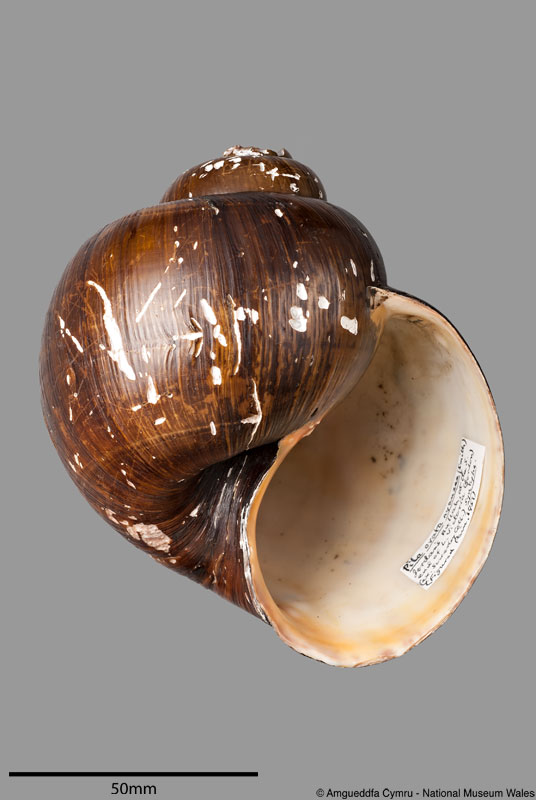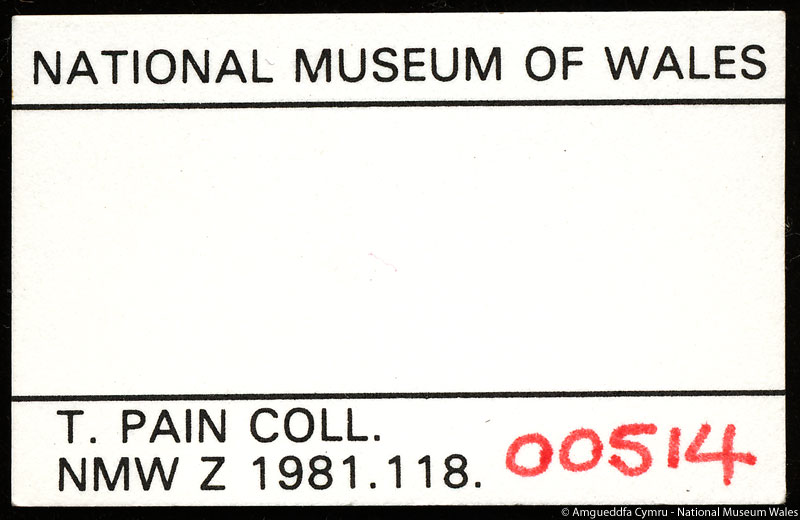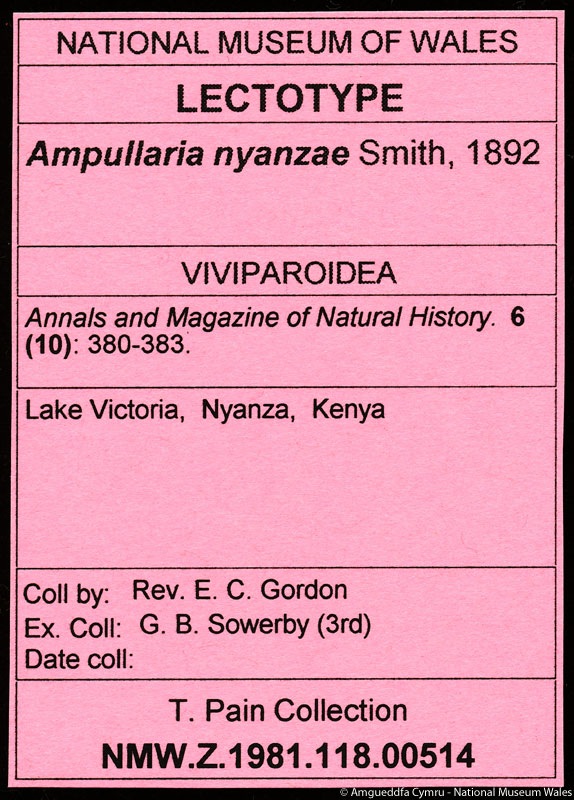 i16936 |
 i17071 |
 i17072 |
Ampullaria nyanzae Smith, 1892
Gastropoda : Viviparoidea : Ampullariidae| Type Status: | Lectotype |
| Collection: | T. Pain |
| Accession No.: | NMW.Z.1981.118.00514 |
| Preparations: | Dry shell |
| No. of Specimens: | 1 sh |
| Locality: | Lake Victoria, Nyanza, Kenya |
| Collecting Details: | Rev. E. C. Gordon, (ex.Coll.) G. B. Sowerby (3rd) |
References
Reference |
Citation |
Reference available |
|---|---|---|
| Smith, E. A. 1892. Additions to the shell-fauna of the Victoria Nyanza or Lake Oukerewe. Annals and Magazine of Natural History. 6(10): 380-383. [382] | Original Description |  request |
| Pain, T. 1951. On the type of Pila nyanzae (Smith, 1892). Proceedings of the Malacological Society. 28(6): 230-231; pl. 28, figs 1-4. [230-231; pl. 28, fig. 2] | Cited Figured Type Designation |
 request |
| Pain, T. 1952. Notes on Pila ovata (Oliver) and its distribution in Africa. Revue de Zoologie et de Botanique Africaines . 46: 286-292. [290] | Cited |  request |
| Pain, T. 1961. Revision of the African Ampullariidae species of the genus Pila Roding 1798 (Mesogastropoda, Architaenioglossa, Mollusca). Musee Royal de L’Afrique Centrale - Tervuren, Belgique Annales. series in 8, 96: 1-29. [15] | Cited Type Designation |
Detailed Locality
| Verbatim Locality |
| Label: Jordan’s Nullah at the S. end of the L. Victoria (Gordon) (ex. Sowerby coll.). Smith, 1892: A creek, commonly called Jordans Nullah at the south end of the lake. Pain, 1951: Lake Victoria, Nyanza. E. C. Gordon. |
| Point Locality: | Lake Victoria, |
| Country: | Kenya |
| Station: | |
| Grid ref./Coordinates: |
| Region: | Nyanza, |
| Sea Region: | |
| Altitude: | |
| Depth: |
| Expedition: | |
| Ex. Collection: | G. B. Sowerby (3rd) |
| Collecting date: | |
| Collected by: | Rev. E. C. Gordon |
Classification
Kingdom |
Phylum |
Class |
Order |
Superfamily |
Family |
|---|---|---|---|---|---|
| Animalia | Mollusca | Gastropoda
Subclass: Prosobranchia |
Mesogastropoda | Viviparoidea | Ampullariidae |
Remarks
Other types:
Paralectotype:- NMW.Z.1981.118.00119 1 spec. (figured in Kobelt, 1912: pl. 30a, fig. 1).
Paralectotype:- NHMUK 1892.8.27.1-3 1 spec. (it is noted at NHM that there were originally 3 specimens but that two were stolen (R. Cowie pers comm.))
Type evidence:
Pain (1951) refers to there being a Sowerby manuscript label, with the correct type locality and collector, associated with this specimen when it came into his possession with the Sowerby collection. Unfortunately this label was not present when the specimen arrived at NMW and currently only two Tom Pain labels are present, attached to the aperture of the shell. In Pain’s (1951) figure of the specimen (fig. 2) there is clearly a ‘Paratype’ label attached to the outside of this shell, which is not referred to by Pain; this is no longer with the shell either.
This specimen fits the measurements that Smith (1892) gave in his original description except for being 10mm thinner. The same measurements were then used by Pain in his 1952 and 1961 papers.
Pain (1951) originally designated this specimen as a “neotype and possible holotype” on the basis that the single type specimen at the NHM does not fit Smith’s description or dimensions. He concludes from this that Smith’s type is lost. This designation was invalid as it was not deposited in a recognised scientific or educational institution and it did not clearly fulfil the other requirements of the Code (Art. 75) (Rob Cowie pers comm.).
In 1961 Pain went on to designate the same specimen as a lectotype.
Robert Cowie is currently reviewing this species and type material in his Old World Ampullariidae manuscript.
